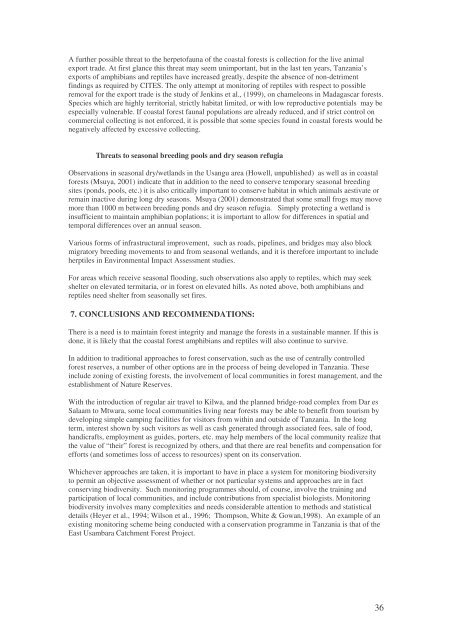UTUMI Biodiversity surveys, annexes, Tanzania. - Coastal Forests of ...
UTUMI Biodiversity surveys, annexes, Tanzania. - Coastal Forests of ...
UTUMI Biodiversity surveys, annexes, Tanzania. - Coastal Forests of ...
You also want an ePaper? Increase the reach of your titles
YUMPU automatically turns print PDFs into web optimized ePapers that Google loves.
A further possible threat to the herpet<strong>of</strong>auna <strong>of</strong> the coastal forests is collection for the live animal<br />
export trade. At first glance this threat may seem unimportant, but in the last ten years, <strong>Tanzania</strong>’s<br />
exports <strong>of</strong> amphibians and reptiles have increased greatly, despite the absence <strong>of</strong> non-detriment<br />
findings as required by CITES. The only attempt at monitoring <strong>of</strong> reptiles with respect to possible<br />
removal for the export trade is the study <strong>of</strong> Jenkins et al., (1999), on chameleons in Madagascar forests.<br />
Species which are highly territorial, strictly habitat limited, or with low reproductive potentials may be<br />
especially vulnerable. If coastal forest faunal populations are already reduced, and if strict control on<br />
commercial collecting is not enforced, it is possible that some species found in coastal forests would be<br />
negatively affected by excessive collecting.<br />
Threats to seasonal breeding pools and dry season refugia<br />
Observations in seasonal dry/wetlands in the Usangu area (Howell, unpublished) as well as in coastal<br />
forests (Msuya, 2001) indicate that in addition to the need to conserve temporary seasonal breeding<br />
sites (ponds, pools, etc.) it is also critically important to conserve habitat in which animals aestivate or<br />
remain inactive during long dry seasons. Msuya (2001) demonstrated that some small frogs may move<br />
more than 1000 m between breeding ponds and dry season refugia. Simply protecting a wetland is<br />
insufficient to maintain amphibian poplations; it is important to allow for differences in spatial and<br />
temporal differences over an annual season.<br />
Various forms <strong>of</strong> infrastructural improvement, such as roads, pipelines, and bridges may also block<br />
migratory breeding movements to and from seasonal wetlands, and it is therefore important to include<br />
herptiles in Environmental Impact Assessment studies.<br />
For areas which receive seasonal flooding, such observations also apply to reptiles, which may seek<br />
shelter on elevated termitaria, or in forest on elevated hills. As noted above, both amphibians and<br />
reptiles need shelter from seasonally set fires.<br />
7. CONCLUSIONS AND RECOMMENDATIONS:<br />
There is a need is to maintain forest integrity and manage the forests in a sustainable manner. If this is<br />
done, it is likely that the coastal forest amphibians and reptiles will also continue to survive.<br />
In addition to traditional approaches to forest conservation, such as the use <strong>of</strong> centrally controlled<br />
forest reserves, a number <strong>of</strong> other options are in the process <strong>of</strong> being developed in <strong>Tanzania</strong>. These<br />
include zoning <strong>of</strong> existing forests, the involvement <strong>of</strong> local communities in forest management, and the<br />
establishment <strong>of</strong> Nature Reserves.<br />
With the introduction <strong>of</strong> regular air travel to Kilwa, and the planned bridge-road complex from Dar es<br />
Salaam to Mtwara, some local communities living near forests may be able to benefit from tourism by<br />
developing simple camping facilities for visitors from within and outside <strong>of</strong> <strong>Tanzania</strong>. In the long<br />
term, interest shown by such visitors as well as cash generated through associated fees, sale <strong>of</strong> food,<br />
handicrafts, employment as guides, porters, etc. may help members <strong>of</strong> the local community realize that<br />
the value <strong>of</strong> “their” forest is recognized by others, and that there are real benefits and compensation for<br />
efforts (and sometimes loss <strong>of</strong> access to resources) spent on its conservation.<br />
Whichever approaches are taken, it is important to have in place a system for monitoring biodiversity<br />
to permit an objective assessment <strong>of</strong> whether or not particular systems and approaches are in fact<br />
conserving biodiversity. Such monitoring programmes should, <strong>of</strong> course, involve the training and<br />
participation <strong>of</strong> local communities, and include contributions from specialist biologists. Monitoring<br />
biodiversity involves many complexities and needs considerable attention to methods and statistical<br />
details (Heyer et al., 1994; Wilson et al., 1996; Thompson, White & Gowan,1998). An example <strong>of</strong> an<br />
existing monitoring scheme being conducted with a conservation programme in <strong>Tanzania</strong> is that <strong>of</strong> the<br />
East Usambara Catchment Forest Project.<br />
36

















